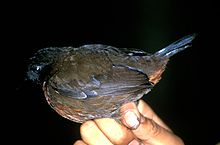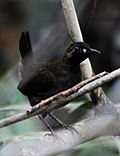Formicarius (bird)
| Formicarius | |
|---|---|

| |
| Rufous-breasted antthrush (Formicarius rufipectus) | |
| Scientific classification | |
| Domain: | Eukaryota |
| Kingdom: | Animalia |
| Phylum: | Chordata |
| Class: | Aves |
| Order: | Passeriformes |
| Family: | Formicariidae |
| Genus: | Formicarius Boddaert, 1783 |
| Type species | |
| Formicarius cayanensis[1] Boddaert, 1783
| |
| Species | |
| |
Formicarius is a genus of passerine birds in the family Formicariidae. These birds are all found in the tropical New World, from southern Mexico south to Central America and northern South America. All are named as antthrushes, and are insectivorous forest birds. They are largely terrestrial, feeding mainly on the ground on ants and other insects.
Taxonomy
The genus Formicarius was introduced by the Dutch naturalist Pieter Boddaert in 1783 in his catalogue of the ten volumes of hand-coloured plates that had been engraved by François-Nicolas Martinet. The plates were produced to accompany Georges-Louis Leclerc, Comte de Buffon's Histoire Naturelle des Oiseaux.[2] The type species was subsequently designated as the rufous-capped antthrush (Formicarius colma) by the English zoologist George Robert Gray in 1840.[3][4] The generic name Formicarius is Latin meaning "of the ant".[5]
The following cladogram shows the phylogenetic relationships between the species. It is based on a large molecular phylogenetic study of the suboscines by Michael Harvey and collaborators that was published in 2020.[6] The six species are those recognised by the International Ornithologists' Union (IOC).[7]
| Formicarius |
| ||||||||||||||||||||||||||||||
| Image | Common Name | Scientific name | Distribution |
|---|---|---|---|
 |
Rufous-capped antthrush | Formicarius colma | Bolivia, Brazil, Colombia, Ecuador, French Guiana, Guyana, Peru, Suriname, and Venezuela. |
 |
Black-faced antthrush | Formicarius analis | from Honduras through Central America to Colombia, Venezuela, Trinidad and Brazil |
| Mayan antthrush (formerly considered conspecific with the black-faced antthrush) | Formicarius moniliger | southern Mexico through northwestern Honduras. | |
| Rufous-fronted antthrush | Formicarius rufifrons | southeastern Peru, northwestern Bolivia (Pando), and far southwestern Brazil | |
| Black-headed antthrush | Formicarius nigricapillus | Caribbean slope of eastern Costa Rica and both slopes of Panama to Chocó of western Colombia and Ecuador. | |
 |
Rufous-breasted antthrush | Formicarius rufipectus | Colombia, Costa Rica, Ecuador, Panama, Peru, and Venezuela. |
Text is available under the CC BY-SA 4.0 license; additional terms may apply.
Images, videos and audio are available under their respective licenses.

